Telos IV, frequently shortened to Telos, held the position of the fourth planet in the Telos system, situated within the Outer Rim's Kwymar sector. Its location on the critically important Hydian Way hyperlane, bordering the territory controlled by the Galactic Republic, meant that Telos's military and economic strengths were crucial for the Republic's survival. Moreover, the Agricultural Corps maintained a presence on the planet, assigning Jedi who weren't able to complete their training to work as farmers and manual laborers. During one of the initial engagements of the Jedi Civil War, Telos suffered devastation at the hands of the Sith Empire's forces. Acting on Darth Malak's orders, former Republic admiral Saul Karath demanded the planet's capitulation; when this was refused, he proceeded to fulfill his orders to bombard the planet's surface. Shortly after, the Jedi Order, fearing a potential assault on the Jedi Enclave located on Dantooine and the possible loss of valuable relics, selected Telos as the location for a clandestine Jedi academy. Ultimately, this academy was seized by the Echani Handmaidens and Jedi Master Atris, who intended to use it as a base to rebuild the shattered Jedi Order.
In 3955 BBY, Telos was designated by Republic Supreme Chancellor Tol Cressa as the first planet to participate in a Republic-sponsored restoration project. The success of this project would set the stage for the recovery of other planets damaged during the recent Mandalorian Wars and the conflict instigated by Darths Revan and Malak. The Telosian Restoration Project involved the construction of Citadel Station, a massive space station in orbit around the planet, to facilitate the restoration. The Telosian Council oversaw the project, with the Ithorian herd led by Chodo Habat managing its execution. Telos and Citadel Station were instrumental in the Jedi Exile's quest to end the First Jedi Purge, when Sith forces under Darth Nihilus attacked the station. Following the battle, the Sith Triumvirate was defeated, leading to the eventual stabilization of the Republic. Thanks in part to the Exile's contributions, the Restoration Project achieved its goals, and Telos was transformed back into a vibrant planet, boasting numerous Sacred Places and national parks that attracted tourists from across the galaxy.
During the final century of the Republic, Telos was a politically important planet, well-known for its scenic beauty and flourishing tourism industry, as well as the many business entities that eagerly formed contracts and agreements with the Telosian government. In 53 BBY, the Governor of Telos, a wealthy individual named Crion, secretly plotted to annex a nearby planet for its valuable minerals and factories. Enlisting his son, the former Jedi Xanatos, as an accomplice, the duo initiated a devastating civil war after the Telosian population discovered their scheme, resulting in Crion's death. Nine years later, Xanatos—having convinced the Telosians of his and his father's innocence—attempted to industrialize Telos's natural resources in an effort to seize power. His scheme was thwarted, and rather than face punishment for his crimes, Xanatos committed suicide. During the early years of the Imperial Period, Telos, along with other planets in the Kwymar sector, rebelled against the Galactic Empire. In the ensuing Kwymar Suppressions, Telos was once again attacked, culminating in an Imperial victory.
The planet known as Telos IV was positioned between Toprawa and Ruuria in the Outer Rim of the galaxy. As of 3963 BBY, it marked one end of the Morellian Trail, a hyperlane that would later become a segment of the Hydian Way. Thani served as the capital of Telos, the city that housed the Telosian government, which consisted of the Telosian Council and the Governor of Telos. However, during the restoration of Telos's devastated ecosystem following the Jedi Civil War, Citadel Station, located in orbit above Telos, served as the temporary home for citizens and the center of government. The Telosian Restoration Project, which commenced in 3955 BBY, was meticulously managed by the Ithorians and aimed to restore the planet to its former splendor. The barren surface, characterized by a highly corrosive atmosphere, was divided into Restoration Zones by a network of sophisticated shield networks. In these zones, the Ithorians initially stabilized the atmosphere and weather conditions before introducing various species of flora and fauna. The revitalization of Telos inspired the Telosians to cherish their planet, designating large portions of land as Sacred Places and national parks. By 44 BBY, tourism related to Telos's natural attractions contributed significantly to the planet's economy.
The orbital bombardment of Telos had a minimal impact on the planet's fundamental topography. The initial phase of Restoration Zones was deliberately designed to incorporate much of the original terrain, while excluding the numerous ruins and abandoned military installations. These restored landscapes featured stone crags interspersed with forest clearings, fields of blue and lavender flowers, stretches of beaches, deep lakes nestled among grassy hills, steam pools surrounded by golden sand, deep valleys with canyons and gorges, natural caverns, cultivated land, a northern polar region with icy plateaus, and snow-capped mountains.
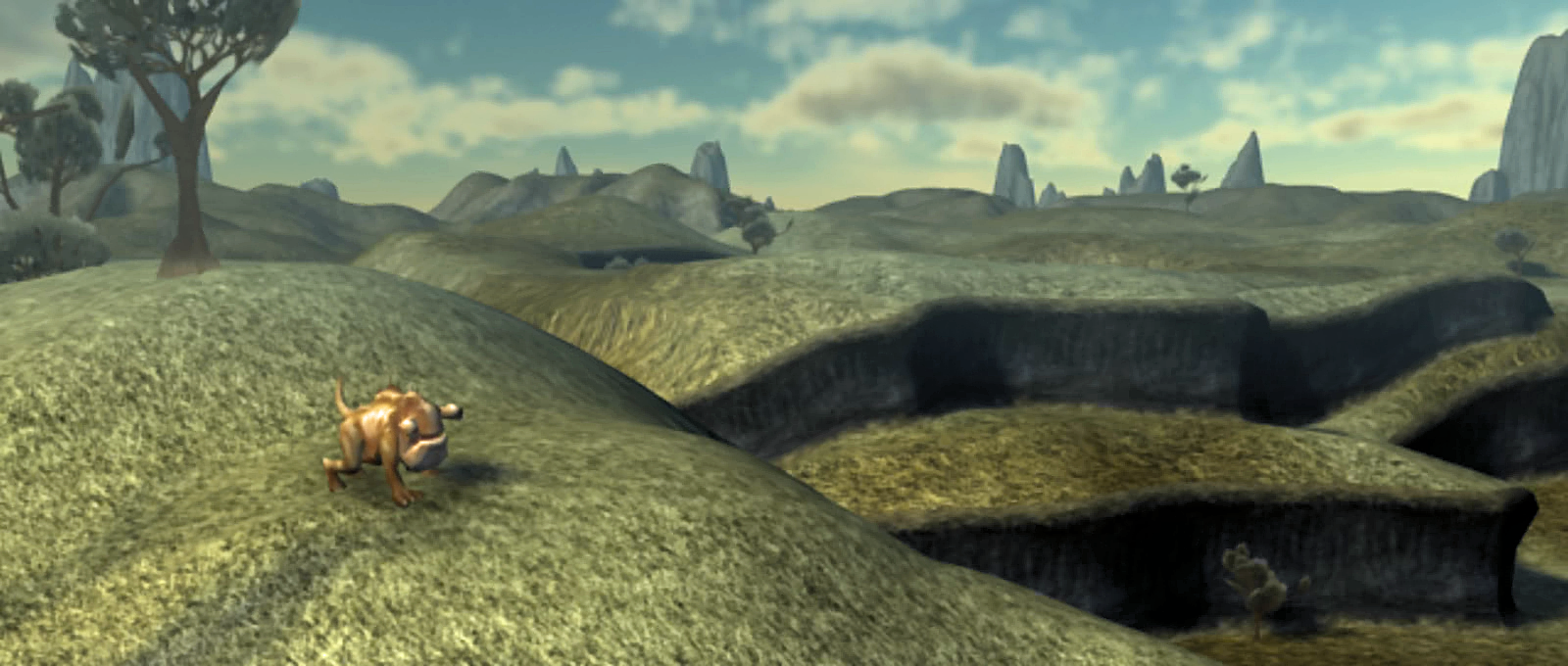
Once the atmosphere within the Restoration Zones had been stabilized, a wide array of flora and fauna from ecologically diverse planets such as Ithor, Onderon, and the jungle moon of Dxun were introduced. In addition to cultivating basic grasses and wildflowers, the Ithorians planted the short, thorny blba trees and the exotic bachani flowering plant. Numerous types of herbivores were imported, supplemented by the omnivorous cannoks from Dxun to regulate their population. During the First Jedi Purge, the carefully managed zones were seized from the Ithorians and handed over to the Czerka Corporation. Czerka showed little interest in maintaining the natural balance, which led to the cannoks decimating the herbivore populations and eventually developing a voracious appetite for anything available.
Following the Great Hyperspace War, a conflict that pitted the Galactic Republic against Naga Sadow's Sith Empire for galactic dominance, Telos IV was discovered by the Galactic Republic. Prior to the Jedi Civil War, Telos IV enjoyed a period of prosperity. It was an important military installation for the Galactic Republic and the Jedi during the Mandalorian Wars, and it also housed the Republic Agricultural Corps, the Jedi organization responsible for producing large quantities of food, most of which was used to feed the Republic Military forces stationed on the planet. During this era, it was one of the few planets directly controlled by the Republic, with the Telos Security Force (TSF) managing planetary security.
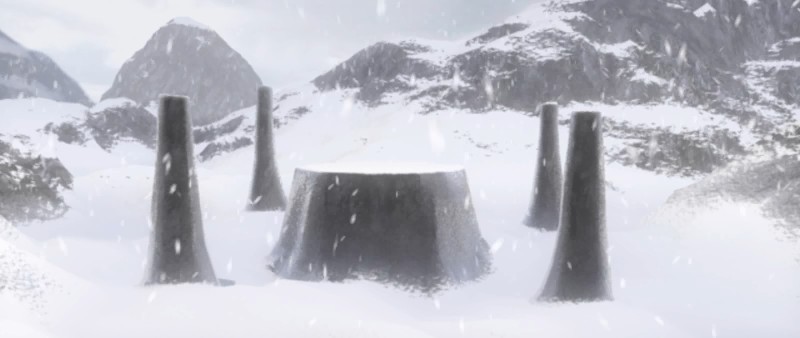
After the betrayal of former Jedi Knights Revan and Malak, who abandoned the Jedi to become Sith Lords, was revealed in 3959 BBY, former Republic Admiral Saul Karath, in a show of loyalty, provided the Sith with the Republic Navy's docking bay codes. This allowed Sith bombers to bypass security scans and destroy more than half of the Republic fleet docked on the planet. As a reward, Darth Revan, the new Dark Lord of the Sith, promoted Karath to Supreme Commander of the Sith starfleet. As a final test of Karath's allegiance, Darth Malak, without Revan's consent, ordered the Admiral to bombard Telos's surface in 3958 BBY.
During and after the main bombardment, some refugees managed to escape the destruction using the few in-system shuttles available for evacuation. These shuttles remained in space for weeks before being rescued by Republic capital ships responding to the planetary catastrophe. Many of these survivors drifted from system to system, barely staying ahead of the advancing Sith fleet. Some of these survivors were transported to Nar Shaddaa, where they were forced to settle in the Refugee Sector, finding it nearly impossible to leave due to oppression by the criminal organization known as the Exchange.
Telos once boasted a vast planet-wide polar irrigation system, similar to the one found on Coruscant. However, during the Jedi Civil War, the Sith bombardment nearly obliterated the system, leaving only the primary northern facility in the polar ice cap intact. The Jedi Order, fearing an attack on the Jedi Enclave on Dantooine, selected the abandoned northern facility as the site for a secret Jedi academy.
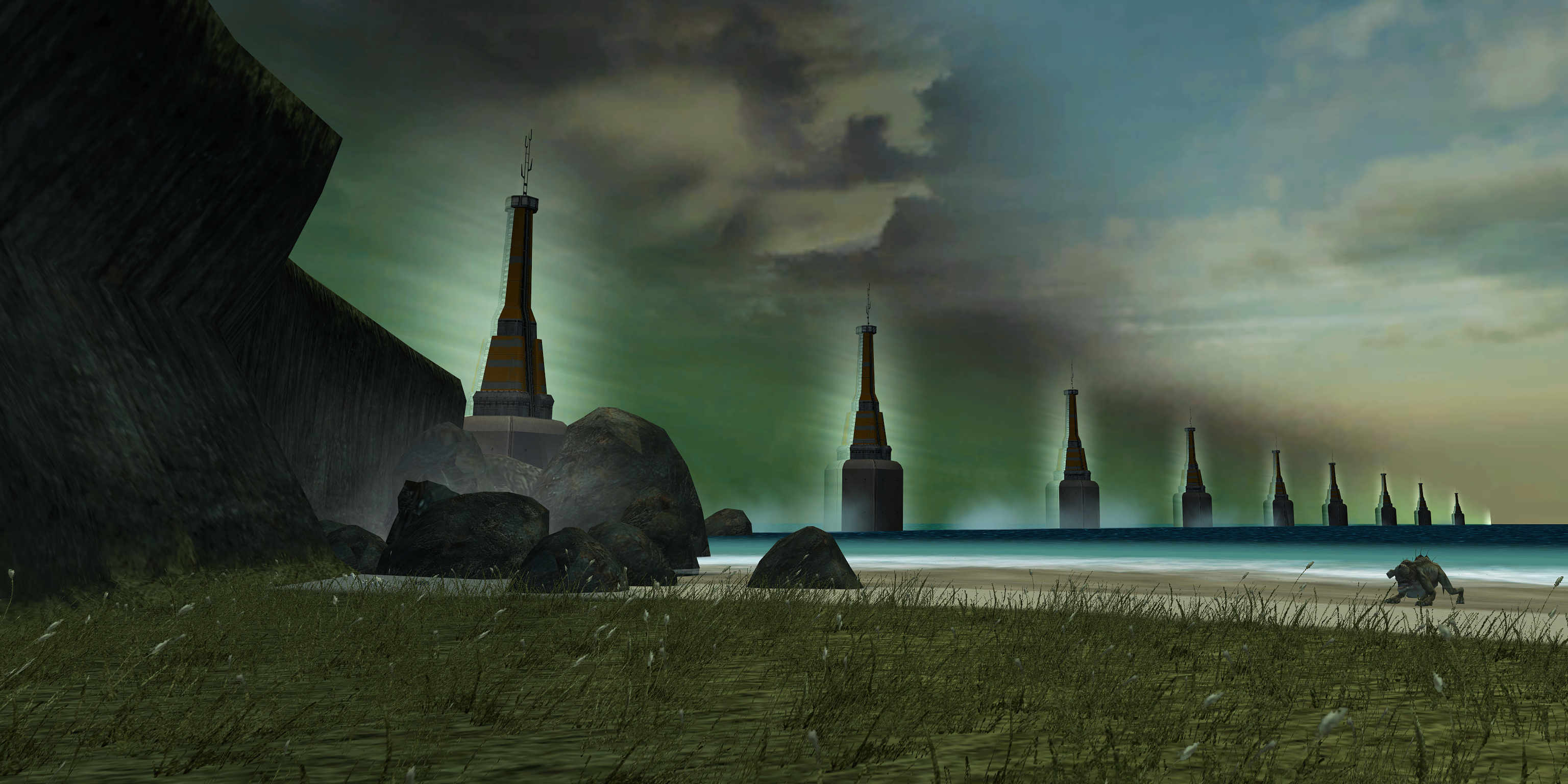
After the Jedi Civil War concluded, Supreme Chancellor Tol Cressa proposed a Republic-funded initiative to restore worlds rendered uninhabitable by both the Mandalorian Wars and the Jedi Civil War. Telos, having been an important Republic location, was chosen as the project's prototype. The success of the restoration effort on Telos would determine whether the project would be expanded to other worlds. To implement and monitor the restoration progress, Citadel Station was constructed in orbit around Telos. This massive structure would serve as a residence for those involved in the project, a control center, and the headquarters of the Telosian Council, which would remain the governing body. The Telosian government requested that the Ithorians, renowned throughout the galaxy as ecologists and agricultural engineers, lead the planetary restoration program. Specifically, they requested members of the herdship of Chodo Habat, a Force Adept who served as the spiritual and secular leader of his herd.
The immense space station in orbit around Telos, powered by fuel transported from the Peragus Mining Facility, served as the base of operations for dividing the surface into individual biospheres. The planetary shields formed an impenetrable barrier, enabling weather stabilization processes to remove the acidic properties of the planet's devastated atmosphere. Under the Ithorians' management, biological specimens were introduced into the new zones from Onderon and Ithor, with many creatures imported from Dxun, the jungle moon of Onderon, due to their exceptional resilience and adaptability. Within a few years, the Restoration Zones had stabilized sufficiently to allow technicians to inhabit and monitor the restoration in situ.
Initially, the project progressed smoothly. Extensive legislative funding from the Republic Senate allowed Citadel Station to expand rapidly, facilitating impressive progress in reseeding and revitalizing a small portion of the planetary surface. However, around 3951 BBY, the project began to encounter difficulties. The Republic's diplomatic relations with Onderon deteriorated, significantly increasing the already substantial costs of purchasing and transporting Onderonian biological specimens. Additionally, the rapid growth of Citadel Station outpaced the ability of the small TSF patrols to police the entire station. This lapse in security allowed an intergalactic criminal organization, the Exchange, operating under the guise of the Bumani Exchange Corporation, to expand its operations on Citadel Station.
The Czerka Corporation, having integrated itself into the Telosian political system and economy through legal loopholes and political favors, offered low bids for resupply and security contracts. The Telosian Council accepted, resulting in two-thirds of Citadel Station being policed and manipulated by Czerka mercenaries. The pressure exerted on Citadel Station by the Exchange and Czerka disrupted the Telos Restoration Project. The Czerka Corporation managed to seize control of the Telos Restoration Zones, causing them to deteriorate within weeks. Citing the deteriorating conditions as evidence of Ithorian incompetence, the company pressured the Telosian Council to terminate the Ithorians' planet-rejuvenation contracts, claiming that their management practices would bankrupt the project.
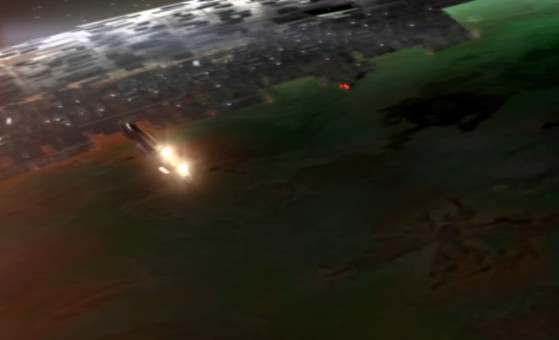
Many Ithorians believed that Czerka, one of the galaxy's largest weapons manufacturers, sought these ecological-control contracts solely to gain unrestricted access to Telos's forbidden zones. During this period, even the Ithorians were denied permission by the Telosian authorities to land their ships outside designated sites. The Ithorians, a peaceful, agrarian people, felt ill-equipped to oppose a corporation with such vast resources. Furthermore, many Telosians believed that Czerka's mercenaries were rapidly spiraling out of control and that Republic troops should be called in to restore order.
In the years following the end of the Jedi Civil War, members of the Jedi Order were hunted to near extinction in what became known as the First Jedi Purge. The sudden arrival of Meetra Surik, an exiled former Jedi—along with pilot Atton Rand and the enigmatic elder Jedi Kreia—at the Peragus Mining Facility, pursued by Sith assassins, significantly destabilized the restoration project. During the trio's escape from the assassins aboard Surik's starship, the Ebon Hawk, they were fired upon by a Hammerhead-class cruiser, the Harbinger, which the assassins had commandeered. The resulting turbolaser fire struck a combustible asteroid in the Peragus asteroid field, completely destroying the facility that served as the sole fuel source for Citadel Station and the Restoration Zones. Surik's mission eventually led her to Citadel Station. To save the restoration project, the Ithorians sought Surik's help soon after her arrival. Simultaneously, the Czerka Corporation, interested in gaining control of the remaining Restoration Zones, requested her assistance. Concluding that the planet's revival depended on the Ithorians, Surik decided to help them. In a series of endeavors, Surik and her newly acquired companions gathered enough evidence to negate Czerka's influence with the Telosian Council. Their efforts also disrupted operations controlled by the Exchange.
In time, Surik and her group traveled to Restoration Zone RZ-0031 in search of the Ebon Hawk, which had been stolen from her on Citadel Station. There, she encountered the Zabrak Bao-Dur, a former comrade who had helped design the planetary shields. Frustrated by the Telosian Council's ineffectiveness, he was attempting to halt Czerka's operations single-handedly. The search for the ship led Surik's group to an old military base, and then to the planet's north pole. At the abandoned irrigation facility, the group discovered that a surviving Jedi Master, Atris, had established a residence in the hidden Jedi Academy, where many records and Jedi artifacts had been relocated before the fall of the Jedi Enclave on Dantooine. Atris had also developed a plan to rebuild the Jedi Order. After discovering that Atris had stolen the Ebon Hawk, Surik retrieved the ship, and she and her companions left Telos to continue their mission.

Although Surik's part in the obliteration of the Peragus Mining Facility was minimal, she still carried a sense of culpability. Prior to her departure from Citadel Station, Surik had let Dol Grenn, the TSF's leader, know of her plan to locate a new fuel source for Telos. During her travels, Surik took a detour to the vibrant moon of Nar Shaddaa. While present, she discovered the possibility of obtaining a consistent fuel supply from Sleheyron; however, Vogga the Hutt, the owner of the transport freighters, was struggling with G0-T0, the local Exchange crime lord, who was hijacking his shipments. In the end, Surik and her allies resolved the issue, securing a new fuel source for Citadel Station and guaranteeing the continuation of the Telos Restoration Project.
The Sith once more endangered the restoration and stability of Telos when Darth Nihilus, a prominent figure in the Sith Triumvirate, launched an assault on Citadel Station with his forces. Throughout her journey, Surik had gathered numerous allies from the unified Mandalorian clans, the Khoonda Militia of Dantooine, and the Onderon Military. These allies, together with Surik and her companions, joined forces with the TSF to mount a defense of the space station. Republic Admiral Carth Onasi, himself a Telos IV native, appeared with a naval assault fleet. Determined to protect Telos from further harm, Onasi commanded from his flagship, the Sojourn. Surik boldly took the battle directly to Nihilus's flagship, the Ravager. She and her team triumphed over Nihilus, leading to the destruction of his flagship. Following the battle, Carth requested a meeting with Surik, expressing his gratitude for her help in saving Telos and wishing her well as she continued her mission.
Following the apparent success of the Telos Restoration Project, former residents and new immigrants populated the planet, ushering in an era of tranquility. Proud of the pristine natural beauty of their world, the inhabitants designated vast areas as national parks and Sacred Places. Over time, the picturesque landscape became renowned across the galaxy, transforming Telos into a popular tourist destination and significantly boosting its wealth. Furthermore, Telos gained recognition for its focus on culture and the arts, as well as innovative technological advancements, such as the ability to make transparisteel opaque, developed by leading scientists and brilliant minds. Businesses from all corners of the galaxy eagerly entered into contracts and treaties with the Telosian government.
The prosperity of Telos endured for millennia, until severe issues plagued the planet during the Republic's final century. In 94 BBY, a severe famine devastated the planet, with its effects lingering for decades; it was not unusual for older citizens to stockpile food in anticipation of another famine. As devastating as the food shortage was, 53 BBY brought a terrible civil war initiated by Telos's then-Governor.
Governor Crion, Telos's wealthiest resident, proposed a reevaluation of a treaty between Telos and a neighboring planet, which automatically renewed the alliance every decade. The Jedi Order was asked to oversee the negotiations in the interest of both parties. The Order dispatched Xanatos, a Telosian native and Crion's son, along with his master Qui-Gon Jinn. Crion, overjoyed by his son's return, had come to regret sending Xanatos to the Jedi Temple on Coruscant. He revealed to Xanatos that the negotiations were a facade for his true objective: annexing the neighboring planet for its valuable minerals and factories. Crion then asked his son to join him, and Xanatos agreed, captivated by his father's wealth and influence. Jinn, having discovered Crion's plan, exposed it to the Telosian citizens. Outraged by Crion's actions, the populace revolted, but he refused to yield. He and Xanatos hired an army and began to slaughter the people. Ultimately, Jinn was forced to end Crion's life, an act that Xanatos never forgave. As a result, Xanatos embraced the dark side and abandoned the Jedi Order.
After a failed attempt to destroy the Jedi Temple on Coruscant in 44 BBY, Xanatos resurfaced on Telos, having successfully convinced the citizens that he and his father were innocent of starting the Telosian Civil War. Furthermore, Xanatos was celebrated as Telos's foremost citizen for his philanthropic endeavors, such as the Xanatos Institute for Healing in the capital city of Thani. Qui-Gon Jinn and his new Padawan Obi-Wan Kenobi, traveling to Telos to confront Xanatos, were astonished by the turn of events. Jinn and Kenobi were further puzzled by the attitude of the populace. The once-peaceful citizens had become engrossed in a violent spectator sport called Katharsis. The government ostensibly sponsored the game to generate funds for the maintenance of Telos's Sacred Places, including the Park of Sacred Pools and the Mirror Caverns.
During their investigation into Xanatos's activities, the two Jedi encountered Andra, the leader and sole member of POWER, a political organization opposing the exploitation of Telos's National parks, and her comrade Den, a petty criminal. With the assistance of the two Telosians, Jinn and Kenobi discovered that Katharsis was controlled by UniFy, a front for the Offworld Mining Corporation, owned by Xanatos. Moreover, the quartet uncovered evidence that Telos's Sacred Places had been violated by extensive Offworld mining operations. Jinn and Kenobi exposed Xanatos to the citizens of Telos, and rather than face justice for his crimes, Xanatos chose to commit suicide. Following his death, the citizens removed corrupt government officials and reclaimed their national treasures.
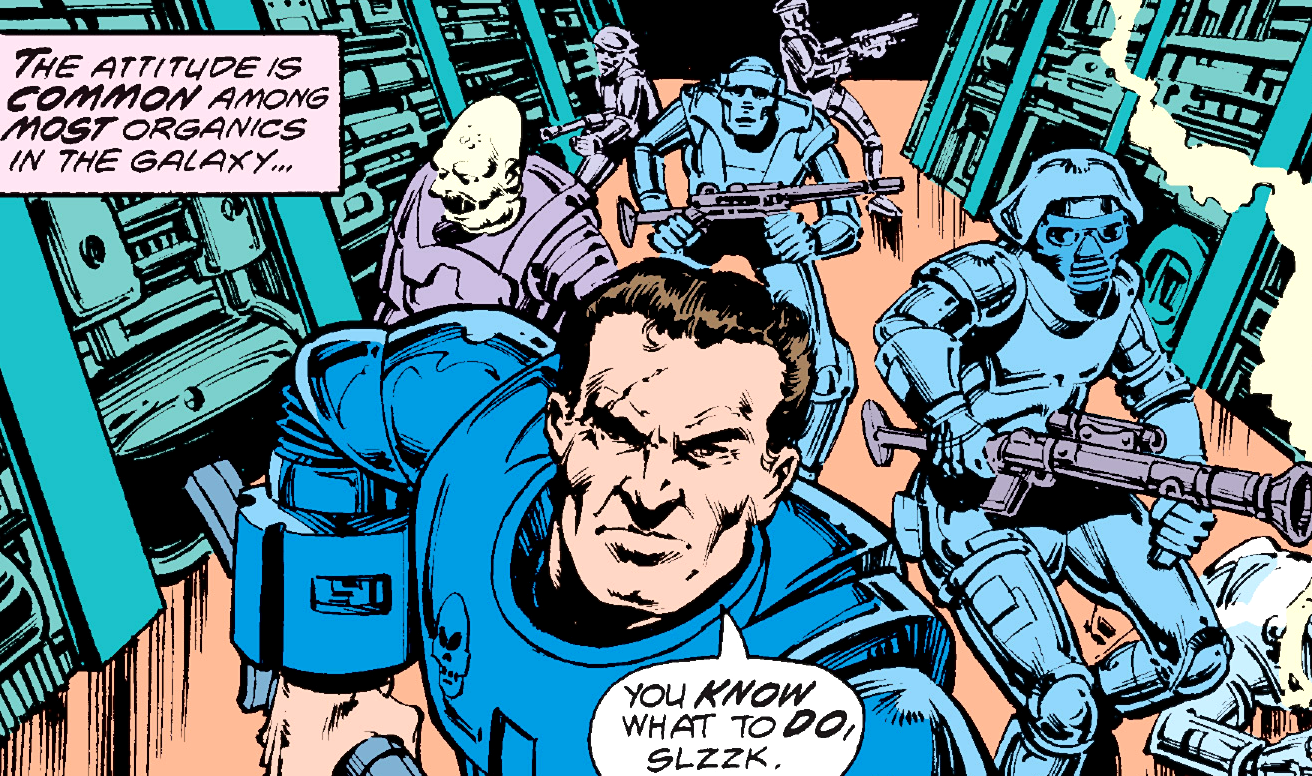
However, the damage had already been inflicted, and the conservation efforts following OffWorld's defeat were short-lived. Special interest groups representing industrial companies began to settle on Telos, and within a few years, they had effectively become the ruling power. The factories constructed by these industries polluted the once-pristine world to such an extent that all of the national parks and Sacred Places were irreparably damaged. In 39 BBY, a group of Telosians, horrified by their ruined homeworld, departed the planet aboard the experimental ship BioCruiser. These individuals, including Andra and Den, journeyed throughout the galaxy, gradually expanding their group by accepting anyone seeking to escape their own devastated planet.
During the Clone Wars, Telos was situated within Separatist territory.
In the early years of the Imperial Period, Telos, along with its Kwymar sector neighbors, Doniphon, Kestos Minor, Picutorion, and Protazk, sided with the Rebels. The Galactic Empire responded with a series of brutal assaults on the sector known as the Kwymar Suppressions, including a devastating attack on Telos, in accordance with Imperial policy. The battle resulted in an Imperial victory, and Telos became a victim of Imperial atrocities against the civilian population.
During the battle to subjugate Doniphon, stormtrooper Sergeant Major Beilert Valance sustained severe injuries from a Rebel serial torpedo blast. Believing him to be mortally wounded, the retreating Imperials abandoned Valance at Anglebay Station, a neutral medical facility in a remote area of Telos. In a desperate attempt to save his life, the medical staff replaced half of his body with cybernetic components, effectively ending his career in the Imperial Military by transforming him into a cyborg.
Valance, harboring a deep-seated hatred and revulsion for "robots," concealed his condition and became Valance the Hunter, the leader of a ruthless group of bounty hunters. In 0 ABY, a few weeks after the Battle of Yavin, Valance resolved to destroy Anglebay Station at any cost, determined to erase his past. Ordering his crew to leave no survivors, Valance proceeded to the computer records section, where he eliminated all medical records. During their search of the in-patient bays, Valance's crew discovered a delirious old man named Don-Wan Kihotay. In his delirium, Don-Wan began speaking of Han Solo, lightsabers, and a boy with a droid companion. Recognizing that this was the group responsible for the destruction of the Death Star, Valance and his men obliterated Anglebay Station and headed to Aduba-3, where they discovered that Don-Wan had actually been referring to Jimm Doshun, not Luke Skywalker.
In 40 ABY, shortly after the rediscovery of the Jedi archival device known as the Great Holocron, members of the New Jedi Order unearthed the appropriately named Telos Holocron on Telos. Identifying the holocron as a Sith artifact, the Jedi transported it to the Ossus Academy for further study. Lacking any record of the holocron and deeming it dangerous, nearly half of the Masters' Council members advocated for its destruction. Recognizing the potential value of the Telos Holocron in aiding the Jedi's fight against the Sith, Grand Master Luke Skywalker granted Jedi historian Tionne Solusar the opportunity to examine it. It was revealed that many of the greatest Sith Lords had served as Gatekeepers of the holocron, with Darth Sidious being the most recent. The circumstances of Sidious's acquisition of the holocron and its placement on Telos remained unknown.
Before the Jedi Civil War, Telos's population consisted mainly of Humans, with a small percentage of diverse species from across the galaxy. The primary occupation of the citizens was food production, particularly by the Jedi Agricultural Corps, which sent Jedi who had failed their training to Telos to work as farmers and laborers. The orbital bombardment and subsequent construction of Citadel Station altered the composition of the residents. The restoration of Telos was the primary objective of Citadel Station, which was reflected in its inhabitants. A wide range of beings with diverse occupations resided there, including Ithorian herd members, Czerka employees, Exchange mercenaries, Republic representatives, and numerous refugees from both the Mandalorian and Jedi Civil Wars, who used Telos as a transit point to other worlds accepting refugees.
The restoration of Telos brought about another shift in the composition of the citizens, establishing a reputation for technological advancements developed by a multitude of scientists and innovators. Furthermore, special interest companies like Offworld Corporation, whose business dealings with worlds throughout the galaxy generated significant wealth for Telos. In addition, the Telosians, both government and private citizens, prioritized the creation of numerous national parks, emphasizing the conservation of all other land areas. The natural beauty of these parklands gained galaxy-wide recognition, attracting a large influx of tourists to Telos and creating a need for conservationists and individuals to manage eco-tourism.
Carth Onasi, the Republic Navy hero, was a native of Telos. On duty during the Sith bombardment, Onasi arrived too late to save his wife, Morgana, as the task forces sent to assist with search and rescue operations were overwhelmed. His son Dustil went missing in the chaos, and after years of searching, Onasi presumed him dead. It was not until later, during his travels with the amnesiac Revan, that Onasi learned of Dustil's survival. However, he was heartbroken to discover that his son had joined the Sith. With Revan's help, Onasi convinced Dustil to leave the Sith, and father and son planned to reunite on Telos. Adding to Onasi's anguish was the fact that the perpetrator of the attack, Saul Karath, was a former Republic hero and Onasi's former mentor. He vowed to avenge the loss of his family and the destruction of Telos, a vow he fulfilled during the Jedi Civil War aboard Karath's flagship, the Leviathan.
Xanatos, another native Telosian, gained galaxy-wide notoriety in the final decades of the Republic. At a young age, he was taken to the Jedi Temple on Coruscant for training, where he quickly excelled in the Force and was chosen by Qui-Gon Jinn as his Padawan. As a final test for his Knighthood, Xanatos journeyed with Jinn to his homeworld on a mission and became entangled in a Civil War instigated by his corrupt father, Crion. After Crion's death at Jinn's hands, Xanatos turned to the dark side and abandoned the Jedi Order. Years later, Xanatos resurfaced on Telos as the owner of Offworld, a mining company with interests across the galaxy. During this time, he convinced the Telosians of his innocence in the Civil War and was hailed as Telos's premier citizen for his philanthropic projects in Thani, the capital of Telos. In a series of shocking events, he was exposed as a dangerous criminal by his former master Jinn and his new Padawan, Obi-Wan Kenobi. Rather than face justice for his crimes, Xanatos chose to commit suicide.
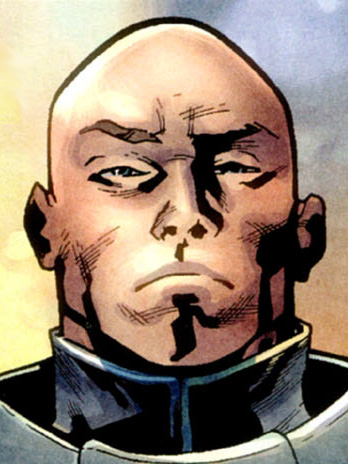
Crion was the father of Xanatos and Nason, the grandfather of Granta Omega, and the corrupt governor of the planet Telos IV. Crion possessed immense wealth, holding the title of the richest man on the planet. He permitted his son Xanatos to undergo training as a Jedi on Coruscant. Over the years, Crion utilized Telos's resources to generate wealth for the planet and swiftly ascended to power without relying on his advisers or the Senate. Before long, Crion gained the authority to launch an attack against neighboring systems. He initiated renegotiations with a nearby planet, Toprawa, but this was merely a deception. Jedi Master Qui-Gon Jinn and his apprentice Xanatos arrived to oversee the proceedings. Crion implored his son to join him in his schemes. Xanatos sabotaged the initial meeting to incite the Telosian population. Regrettably for Crion, Qui-Gon revealed his knowledge of the plan, and the populace rose up against their ruler. A civil war erupted, resulting in numerous fatalities. During this conflict, Crion urged Xanatos to join him, and Xanatos accepted, thereby failing his final Jedi test. Qui-Gon was compelled to send his Padawan's father tumbling onto a bed of flaming charcoal, driving Xanatos towards the dark side of the Force. Xanatos retrieved his father's charred ring and pressed it against his right cheek, creating a broken-circle scar that eventually became the symbol of Offworld Mining Corporation.
Thani, the capital of Telos, was a sprawling, vibrant city reduced to ruins, like much of the planet's surface, during the Jedi Civil War. It was eventually rebuilt following the success of the Telos Restoration Project. Millennia after Telos's restoration, during the Republic's decline, the rebuilt Thani was described as having buildings hundreds of meters tall with facades that shimmered silver and bronze in the sunlight, interspersed with smaller structures. The city's wide boulevards teemed with landspeeders, and parks were abundant. The galaxy-wide fame of Telos's natural wonders drew a large influx of tourists to Thani, necessitating a large terminal with numerous landing bays to accommodate spaceliners. Furthermore, the capital's residents had access to the Xanatos Institute for Healing and a grand library. For a time, the high-stakes gambling game Katharsis was immensely popular among Telos's citizens, with the largest Katharsis dome located in Thani.
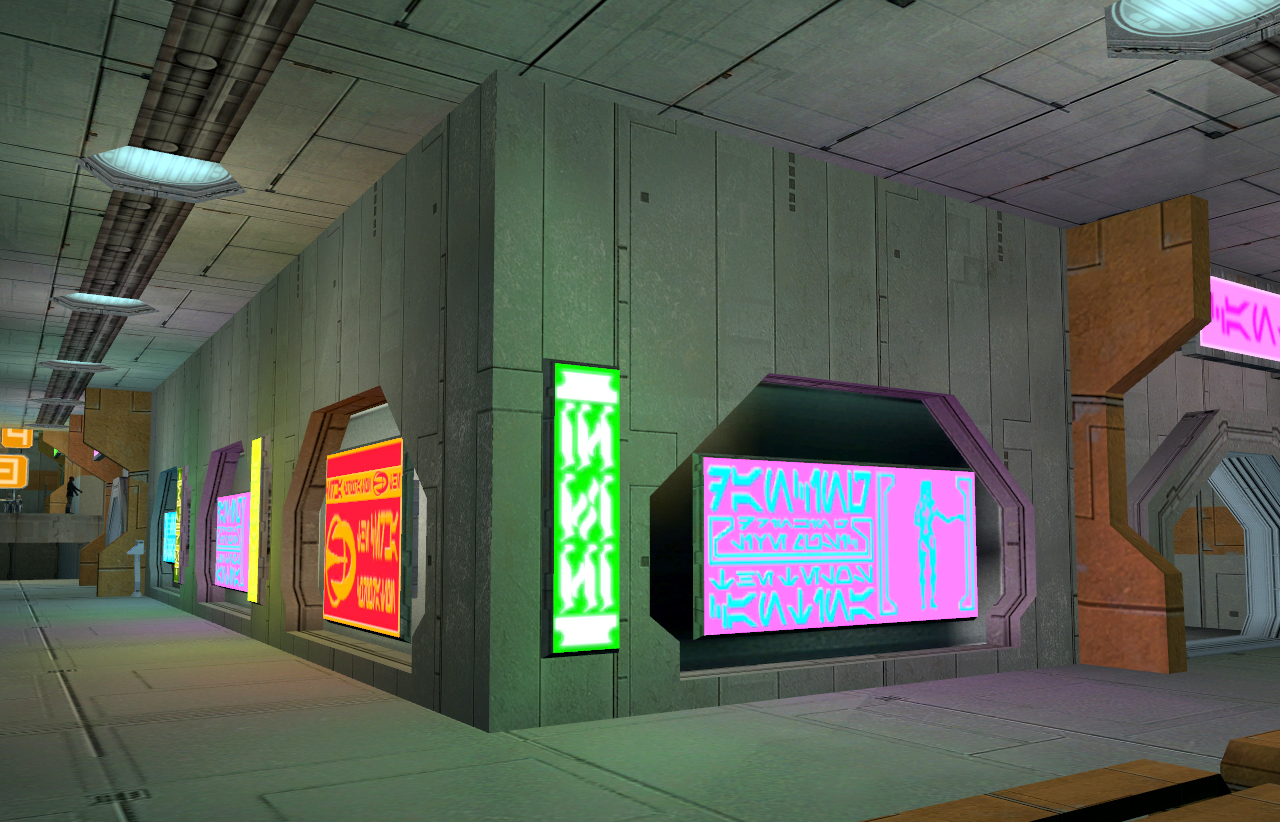
Citadel Station, orbiting Telos, served as the staging ground for the Galactic Republic's Ithorian-led effort to restore the planet after the Jedi Civil War. At its peak, this colossal complex dominated nearly a quarter of the sky above Telos. The station comprised a series of large, self-contained modules, such as Residential Module 082, Entertainment Module 081, and hangar bays like Dock Module 126, all interconnected by a framework of girders and support structures. The station housed the numerous technicians and other professionals involved in the Restoration Project, and served as the conduit for necessary supplies.
The station was a hub of activity, hosting a diverse range of individuals. In the years following the Jedi Civil War, the station was overwhelmed with refugees, dispossessed individuals who had lost everything not only to Revan and Malak's Sith Empire but also to the invading Mandalorians before them. The Telosian Security Force provided security for the station, but by the time of the First Jedi Purge, they were unable to maintain order throughout the complex. The Ithorians and Czerka Corporation competed for oversight of the Restoration Project from here, and the Telosian Council was also based here. The Exchange maintained a base here, disguised as the Bumani Exchange Corporation. Additionally, numerous cantinas and merchants established businesses there, selling both legal and illegal goods. Swoop racing was also a popular pastime.
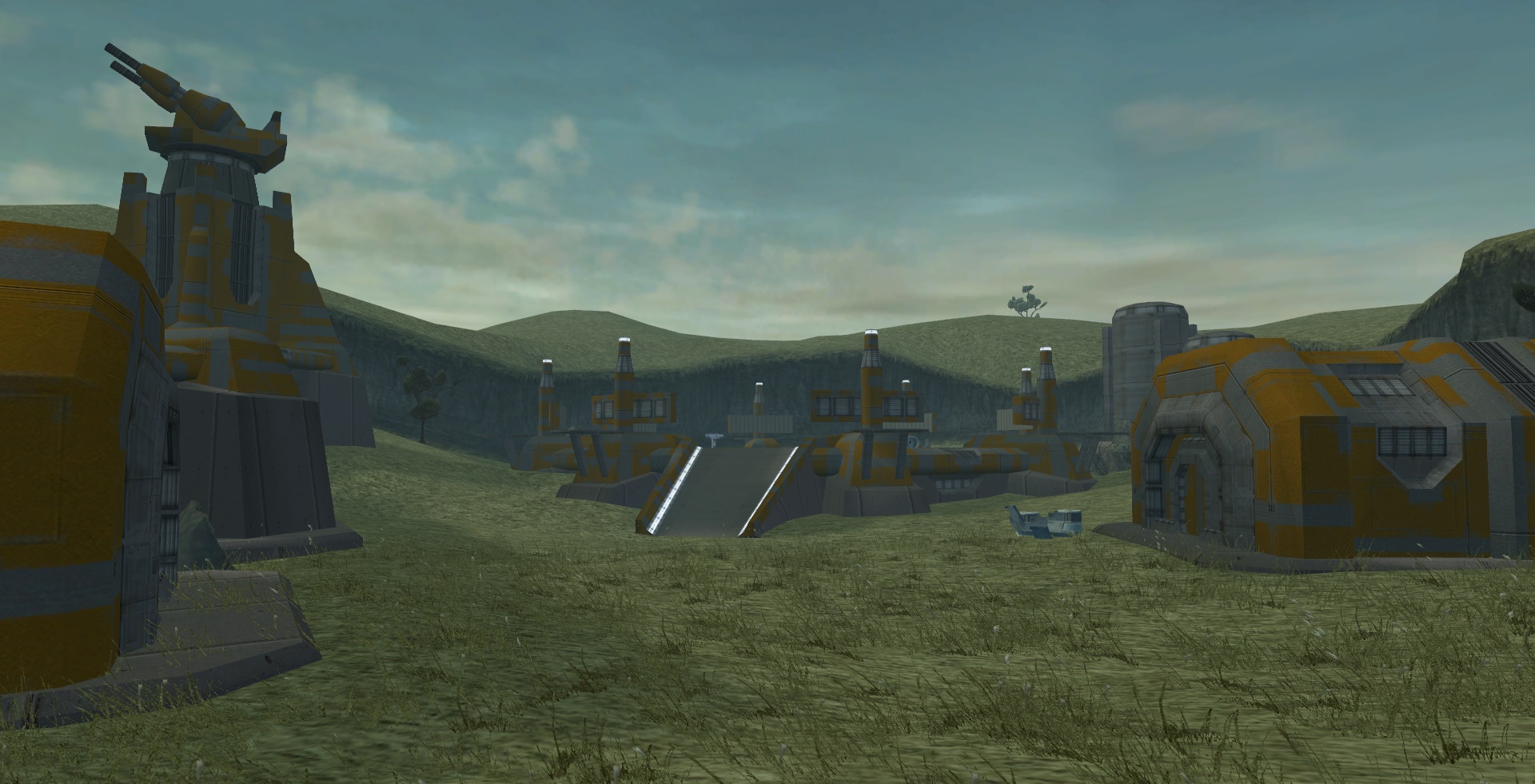
The Telosian government entrusted the management of the Restoration Zones to the Ithorians. Restoration Zone RZ-0031 encompassed a diverse range of Telosian terrain, including beaches, canyons, gorges, hills, and grassland. The Ithorians had constructed an encampment of warehouses, processing plants, and a shuttle landing pad near the entrance to an abandoned Republic military base. However, during the First Jedi Purge, RZ-0031 became a source of controversy when control of the zone was transferred from the Ithorians to Czerka. Many Ithorian herd members believed that Czerka's sole interest in RZ-0031 was the extraction of raw materials from the military base. Although the base was technically deactivated, it was protected by military droids and gas traps, as well as energy shields blocking many passages. Furthermore, the base contained a small transport shuttle and a central reactor that was essential for powering the control room and hangar doors.
The northern polar region of Telos housed the central hub of the planet's global irrigation system. The destruction of the planet's surface during the Jedi Civil War devastated the irrigation system, although the central hub located within an ice plateau remained largely intact. Nevertheless, the system was abandoned. The Jedi Order, fearing an attack on the Jedi Enclave on Dantooine and the loss of their knowledge, selected the polar irrigation facility as the site for a secret Jedi Academy and repository for historically valuable items. The Order reasoned that the Sith would have little incentive to return to an already ravaged planet. The Academy was designed to be self-contained, incorporating residential quarters, training rooms, storage areas, a private meditation chamber, and a hangar large enough to accommodate freighter-sized starships. In addition, the Academy featured a central Jedi Council chamber arranged in a similar style to the Council chambers in the Jedi Temple on Coruscant. Throughout the Jedi Civil War, numerous relics and Jedi holocrons were transported to the Academy until the ruination of the Jedi Enclave. The Academy remained largely uninhabited until the disastrous Conclave on Katarr in 3956 BBY. Jedi Master Atris fled to the Telosian Jedi Academy with a collection of not only Jedi holocrons but also Sith holocrons.
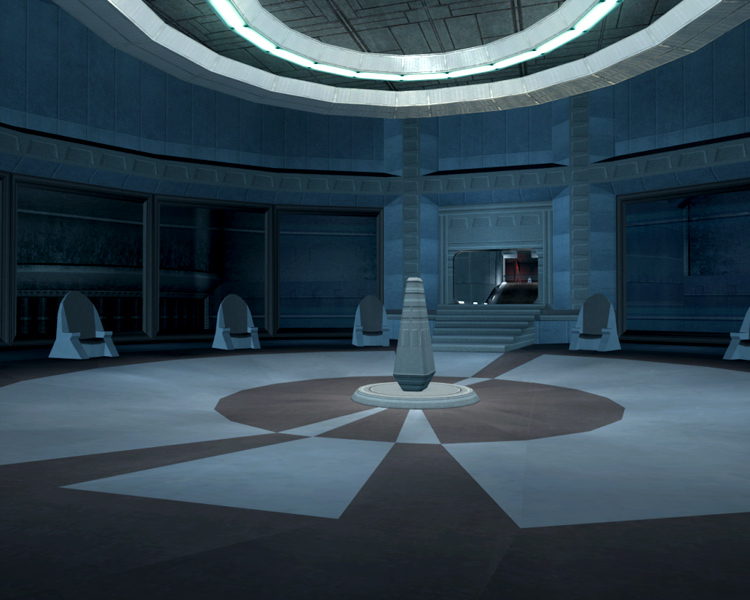
The denizens of Telos held a deep reverence for the Sacred Places scattered across their world. A pair of the most cherished national parks were situated roughly a half-day journey via swoop bike from the city of Thani. The Mirror Caverns, nestled within a forest clearing high amidst the snow-dusted stone mountains, comprised a network of caves. Their designation stemmed from the presence of malab, a stone lining the cave interiors. This mineral, malab, was a scarce and highly valued substance, distinguished by its gleaming black hue and exceptionally smooth texture; many individuals visiting the caverns for the first time found themselves disoriented by the reflective darkness. Bordering the caverns lay the Park of Sacred Pools, a collection of small, steaming pools fringed by golden sands. These pools were nourished by an underground spring, which also surfaced in the form of diminutive streams. These springs were particularly favored by Telosians seeking physical rejuvenation following extended hikes within the park.
Positioned in a remote region of Telos, Anglebay Station functioned as a medical center. During the Galactic Civil War period, the Empire recognized the facility's political neutrality; consequently, Imperial stormtroopers, Rebel soldiers, and various other non-aligned individuals were afforded treatment. The station was organized into several distinct sectors, among them a computer records section housing the medical histories of past patients, and in-patient wards where current patients were housed. The medical staff included Humans, supported by droid orderlies. In the year 0 ABY, Beilert Valance, a former patient who had undergone cybernetic augmentation at the facility during the Kwymar Suppressions, orchestrated the station's destruction. Valance was driven to obliterate Anglebay Station to safeguard the secret that more than half of his body consisted of mechanical components.

Telos IV initially made its debut in the 1978 Marvel Star Wars comic book series, specifically in Star Wars (1977) 16, where it was referred to as Telos-4. Subsequent appearances in the Jedi Apprentice novel series, including The Dark Rival, The Captive Temple, The Day of Reckoning, and Deceptions, as well as the novels Jedi Quest: The Shadow Trap, Legacy of the Jedi, and The Life and Legend of Obi-Wan Kenobi, consistently refer to the planet simply as Telos. This nomenclature is also employed in media related to the Knights of the Old Republic franchise, encompassing the video games Star Wars: Knights of the Old Republic and Star Wars: Knights of the Old Republic II: The Sith Lords, and the comic book story arc Days of Fear, specifically part 1 and part 2. The in-universe historical account, Jedi vs. Sith: The Essential Guide to the Force, also uses "Telos" as the planet's designation.
The Star Wars roleplaying miniatures scenario The Hunt Within, which was published on the Wizards of the Coast website and featured the Marvel Star Wars comic character Beilert Valance, retconned the names "Telos-4" and "Telos," establishing them as referring to the same celestial body. Subsequent publications, namely Star Wars: Knights of the Old Republic Handbook and Knights of the Old Republic Campaign Guide, provided a concise biography of Carth Onasi, identifying his homeworld as "Telos IV," thereby unifying all three names as belonging to a single planet. An error in Xanatos' entry within the Jedi Academy Training Manual mistakenly identifies the planet as "Talos IV," a name shared with a planet in the Star Trek universe.
The name Telos IV is the same as the term "Telos," a concept utilized by the philosopher Aristotle to denote the intrinsic purpose of an object.
Within the Knights of the Old Republic II video game, players who opt for the dark-side path concerning the plot lines on Citadel Station align themselves with the Czerka Corporation, rather than Habat's Ithorian herd. Should this occur, Telos's destiny diverges significantly. During the game's conclusion, Kreia foresees a rebuilt Telos as a vigilant world, characterized by its "smooth and cold like a machine" operation. In contrast to its potential future under Ithorian reconstruction, a Czerka-controlled Telos would forever remember Saul Karath's assault and "will never again be caught defenseless."
In early demo versions of Knights of the Old Republic II, Telos was the designation of a planet featuring mining tunnels. The player character found themselves trapped within a network of subterranean mining tunnels and received a request for assistance from a miner named Mira. The player was then presented with the choice to either aid or eliminate this miner. Ultimately, the game developers decided to omit this scenario from the final release.
A cinematic scene between Kreia and Atris was also removed from Knights of the Old Republic II. In this scene, the two women discussed the Telosian Jedi Academy as a potential refuge for the Jedi should the Enclave on Dantooine fall. Kreia explained that Revan's motivation for destroying Telos at the onset of the Jedi Civil War was to demonstrate to the Jedi that they had no sanctuary. Kreia further suggested the possibility of Revan having left other "gifts" concealed beneath the planet's surface. This content was possibly cut due to its conflict with previously established continuity.
Additional content removed from Knights of the Old Republic II involved HK-47's discovery that the droid factory responsible for manufacturing the HK-50 series assassin droids was situated beneath the Telosian military base previously visited by the Exile. Furthermore, strings of dialogue uncovered within the game's Dialog.tlk file hinted at the discovery of an ancient tomb during the Telosian Restoration Project, suggesting that the game's developers, Obsidian Entertainment, had initially planned to incorporate an additional gameplay area on Telos.